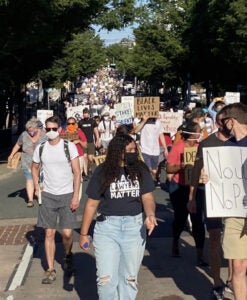Diversity and Inclusion
Diversity and Inclusion:

Our International Family Medicine Clinic (IFMC), lead by IFMC director Dr. Fern Hauck, and other volunteers in our clinic recently opened on a weekend to reach out to our refugee community! The day was a success, to say the least!
We embrace diversity – we know that this makes us stronger and better. Our residency program mission is to create a nurturing and inclusive environment to train future leaders in Family Medicine. We want everyone in our department to feel included, no matter their race, sexual orientation, country of origin, religion, gender identity, ethnicity, or physical abilities.
We have long cared for vulnerable populations within our community, including the elderly, refugees and immigrants, transgender patients, and people experiencing homelessness. We aim to recruit and train residents that reflect the demographics of our community and the patient population that we serve. We employ a holistic approach to recruitment, and strive to diminish implicit bias in the process.
Resident involvement:
The Department of Family Medicine Diversity and Inclusion Committee: The Diversity and Inclusion committee seeks to promote equity, diversity, and inclusion within the Department of Family Medicine. This committee is tasked with identifying and supporting the needs of our colleagues and patients, as well as ensuring that our progress aligns with the School of Medicine’s diversity plan. The committee is comprised of faculty, staff and resident members.
In 2020, the Resident Subcommittee of the Diversity and Inclusion Committee started the Anti-Racism Book Club which is open to all faculty, residents, and staff. The club meets monthly to provide time and space for reflection and discussion on issues of racial inclusivity. The group has read books (White Fragility, How to be an Anti-Racist, Racial Divide in America), watched documentaries (The 13th, I Am Not Your Negro, Aftershock, Raised/Razed), listened to a podcast (1619), and visited the Virginia Museum of Fine Arts to view an exhibit showcasing Black American visual artists (The Dirty South).
Housestaff Council for Diversity and Inclusion: is committed to promoting diversity and tolerance within the housestaff community by building a culture of inclusion and respect, engaging with future housestaff members, and leveraging the diversity of its members in collaboration with the greater Charlottesville community.
Promoting Diversity at UVA:
UVA Family medicine participates in the URiM Leadership Program through the UVA Office of Graduate Medical Education. Click here to visit their site for more information.
See the School of Medicine’s site for information about diversity events and local happenings across grounds.
Trainee Diversity & Inclusion Conference – The GME department works closely with UVA faculty and the Housestaff Council for Diversity and Inclusion to stimulate meaningful conversations about race, privilege and representation in our community. The host a Diversity and Inclusion conference annually.

Some of our residents and faculty at a peaceful anti-racism march with the Charlottesville community from C’ville’s Downtown Mall to the UVA Rotunda!
Family Physicians as Advocates: Our Health Equity Curriculum:
The aim of our longitudinal health equity curriculum is for graduates of UVA Family Medicine Residency Program to be advocates for their patients at the clinic, health system, community, state, national, and international level. To meet this aim, residents learn about social determinants of health, health disparities, the social structures that create and perpetuate health disparities, and the actions family physicians can take to affect change for the promotion of health equity. The curriculum has a particular focus on the historical and present-day impact of racism on health disparities.
In order to understand present-day health disparities in our community, we start with an evaluation of our past. At the time of the arrival of European colonizers in Virginia, the area now called Charlottesville and Albemarle County was home to the Monacan Indians. The Virginia General Assembly established Charlottesville as a town in 1762. The small market town of Charlottesville was surrounded by tobacco and wheat plantations, and by the early 19th century, enslaved Africans and African Americans made up 50% of the population of Albemarle County. In 1817, construction began for Thomas Jefferson’s Central College, which would later become the University of Virginia.
As a public institution, UVA is the embodiment of Thomas Jefferson’s belief that an educated citizenry is necessary to ensure a healthy democracy. It is also emblematic of the central paradox of American history in that slavery was an integral part of its construction and early operations. Through the University President’s Commissions on Slavery and on the University in the Age of Segregation, the institution is honestly accounting its legacy. Over the course of the health equity curriculum, our residents examine the impacts of this legacy on present-day health disparities in Charlottesville and Albemarle County. UVA’s commitment to becoming a Great and Good University, and community-based efforts toward racial justice, make Charlottesville a prime location for training family physicians to become advocates for health equity.
